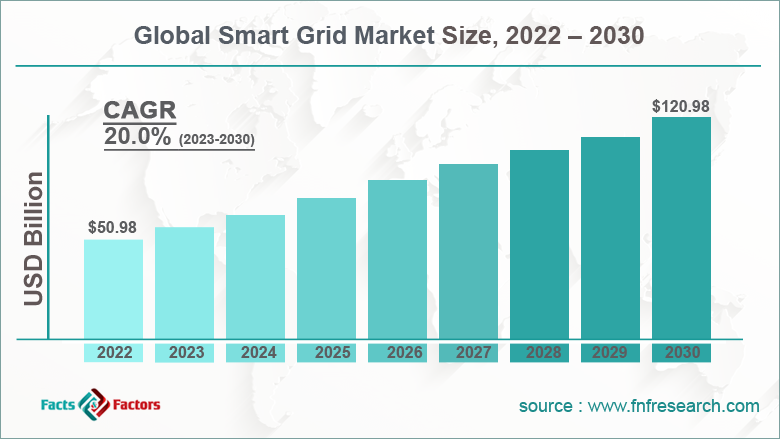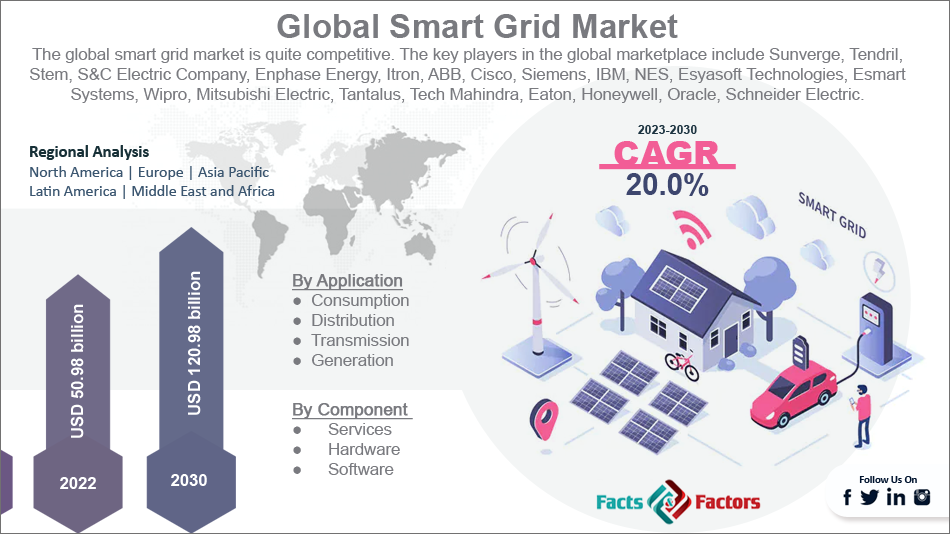Search Market Research Report
Smart Grid Market Size, Share Global Analysis Report, 2023 – 2030

Smart Grid Market Size, Share, Growth Analysis Report By Component (Services, Hardware, and Software), By End-user (Commercial, Residential, Industrial, And Utility sectors), By Communication Technology (Wireless and Wireline), By Application (Consumption, Distribution, Transmission, and Generation), and By Region - Global and Regional Industry Insights, Overview, Comprehensive Analysis, Trends, Statistical Research, Market Intelligence, Historical Data and Forecast 2023 – 2030
Industry Insights
[227+ Pages Report] According to the report published by Facts & Factors, the global smart grid market size was valued at USD 50.98 billion in 2022 and is expected to surpass USD 120.98 billion during the projected period. The smart grid market is expected to move with a CAGR of 20% between 2023 and 2030. The report comprehensively analyzes the market's growth factors, barriers, opportunities, and challenges during the forecast period. Also, it further throws light on the investor's and stakeholder's space to help users in the efficient decision-making process.

 Market Overview
Market Overview
A smart grid is an electricity supply network that enables digital communication between technologies to track in real-time, allow self-healing of networks, and adapt to local changes in case of a power disturbance. It is referred to as an intelligent overlay that helps the existing network to work properly with advanced feedback alternatives like demand response management systems, active network management, and others. It is an advanced interconnected network with analytic tools, digital controllers, sensors, and meters to control, automate, and monitor energy flow.
 Key Insights
Key Insights
- As per the analysis shared by our research analyst, the global smart grid market is estimated to grow annually at a CAGR of around 20% over the forecast period (2023-2030).
- In terms of revenue, the global market size was valued at around $50.98 billion in 2022 and is projected to reach USD 120.98 billion by 2030.
- The growing number of electric vehicles is likely to boost the smart grid market growth.
- Based on the component the software segment accounts for the largest share of the global market.
- Based on the end user, the utility sector dominates the global market.
- Based on the communication technology the wireless communication segment is likely to be the fastest-growing segment in the global market.
- Based on the application the distribution segment accounts for the largest share of the global market
- Based on region, North America is expected to dominate the market during the forecast period.

 Growth Drivers
Growth Drivers
- The growing number of electric vehicles augments the market growth.
Automobile companies are rolling out plug-in electric devices to customers across the globe to promote low-carbon transportation. The smart grid system is innovated with the required infrastructure in plug-in electric vehicles. The growth in the production and sales of electric vehicles in developed and developing countries like Europe, the US, China, and India are likely to contribute heavily towards the growth of the global smart grid market.
 Restraints
Restraints
- Ongoing smart city projects are expected to create lucrative growth opportunities.
The growing initiatives for smart city projects are likely to create more scope in the global smart grid market. Aging grid infrastructure is a major factor offering immense growth opportunities in the global smart grid industry. Growing industrialization is demanding advanced electricity systems, the government is quickly revolutionizing the aging grid infrastructure.
 Opportunities
Opportunities
- High cost of maintenance and deployment of smart grid technology is likely to hamper the growth of the market.
Deploying a smart grid requires heavy investments, which is likely to limit the market's growth. This advanced technology needs high initial investments to install the transmission networks between the grid and the consumers. Furthermore, the high operational and maintenance cost after its deployment is also likely to be a huge concern in the global smart grid market.
 Challenges
Challenges
- Low accessibility to electricity in underdeveloped regions is a big challenge in the global market.
Underdeveloped regions are not still prepared for the deployment of advanced technology. People cannot get a constant supply of electricity in a day, thereby limiting the deployment of smart grid technology in such regions. Furthermore, deploying such technology generates a high volume of complex data associated with transmission logs, utility consumption, and consumer information. Also, it is a complex and unstructured process that needs deep insights. Therefore, continuous data generation from different network nodes is a big challenge in the global smart grid market.
 Segmentation Analysis
Segmentation Analysis
The global smart grid market can be segmented into components, end-user, communication technology, application, and region.
Based on the component, the market can be segmented into services, hardware, and software. The services segment can be further bifurcated into support & maintenance, deployment & integration, and consulting. The hardware segment further bifurcates into the programmable logic controller, sensors, smart meters, and others. The software segment can also be further bifurcated into smart grid security, substation automation, grid asset and management, smart grid distribution management, building & customer information system, smart grid network management, and advanced metering infrastructure.
The software segment dominates the global smart grid market due to the growing efforts to revolutionize the electricity grid and lower losses. The growing investments in advanced electricity infrastructure are further likely to boost the growth of the segment. The hardware segment is also expected to see huge growth rates in the coming years due to the increasing initiatives by governments across the globe for the employment of smart electricity meters. The service segment is also expected to witness significant growth because of its various applications, like integration and installation of different modules of utility grid operations.
Based on end-user, the smart grid industry can be segmented into the commercial, residential, industrial, and utility sectors. The utility sector is predicted to witness significant growth due to the increasing deployment of grid technology globally. Additionally, the governments of developing and underdeveloped countries are increasingly identifying the advantages of strategic infrastructure investment that can lower carbon emission rates and parallelly resolve the surging environmental concerns due to fossil fuel power stations.
However, the industrial sector is predicted to expand significantly during the forecast period owing to the financial investments and favorable policies by the government. The spike in the adoption of electric vehicles is also likely to positively impact the growth trajectory of the segment. Moreover, the residential sector is also expected to see growth in the coming years due to the growing awareness among people regarding the advantages of these advanced technologies, like their cost-effectiveness and low energy consumption across all end users.
Based on communication technology, the smart grid industry can be segmented into wireless and wireline. The wireless communication segment is expected to be the fastest-growing segment in the global smart grid market. It helps to transfer information over distances without using electrical wires or conductors. The wireless technology offers secured transmission and is cost-effective. It further provides integral support by optimizing complex logistics, covering a larger area, and offering high bandwidth.
Based on application, the market can be segmented into consumption, distribution, transmission, and generation. The distribution segment accounts for the largest share of the global market. Power is generated at high volts in the power plants in order to lower the electricity loss. It is later connected to lower distribution lines to supply power to the consumers. Therefore, the distribution segment is of immense importance for implementing smart grids.
 Recent Developments:
Recent Developments:
- Impact Solar, a Thailand-based energy company, partnered with Hitachi ABB Power Grids in May 2021. This partnership was aimed at provisioning an efficient energy storage system for the largest private-owned microgrid in the country.
- Schneider Electric, in January 2021, successfully acquired DC Systems BV, a major supplier of smart systems. This acquisition is expected to help Schneider Electric in advancing innovations in electrical distribution.
 Report Scope
Report Scope
Report Attribute |
Details |
Market Size in 2022 |
USD 50.98 Billion |
Projected Market Size in 2030 |
USD 120.98 Billion |
CAGR Growth Rate |
20% CAGR |
Base Year |
2022 |
Forecast Years |
2023-2030 |
Key Market Players |
Sunverge, Tendril, Stem, S&C Electric Company, Enphase Energy, Itron, ABB, Cisco, Siemens, IBM, NES, C3 Energy, Grid4C, Esyasoft Technologies, Esmart Systems, ENEL X, Xylem, Kamstrup, Globema, Trilliant Holdings, Wipro, Mitsubishi Electric, Tantalus, Tech Mahindra, Eaton, Honeywell, Oracle, Schneider Electric , and others. |
Key Segment |
By Component, End-user, Communication Technology, Application, and Region |
Major Regions Covered |
North America, Europe, Asia Pacific, Latin America, and the Middle East &, Africa |
Purchase Options |
Request customized purchase options to meet your research needs. Explore purchase options |
 Regional Analysis
Regional Analysis
- North America to lead the global market during forecast period
North America holds the largest share of the global smart grid market due to the surge in demand for smart infrastructure in the region. Furthermore, the growing number of smart city projects is likely to augment the demand for automation projects like smart grid solutions, which is likely to accelerate the growth of the regional market in the forthcoming years.
Asia Pacific is predicted to grow significantly in the coming years due to the growth in power consumption in nations like Japan, India, and China. These countries have also raised the requirement to implement new measures to distribute, generate, and use electricity.
Additionally, the growing disposable income of people, along with the increasing living standards, is likely to contribute heavily towards the growth of the regional market. South Korea, Australia, Japan, India, and China are some of the major smart grid technology users in the region.
 Competitive Analysis
Competitive Analysis
- Sunverge
- Tendril
- Stem
- S&C Electric Company
- Enphase Energy
- Itron
- ABB
- Cisco
- Siemens
- IBM
- NES
- C3 Energy
- Grid4C
- Esyasoft Technologies
- Esmart Systems
- ENEL X
- Xylem
- Kamstrup
- Globema
- Trilliant Holdings
- Wipro
- Mitsubishi Electric
- Tantalus
- Tech Mahindra
- Eaton
- Honeywell
- Oracle
- Schneider Electric
The global smart grid market is segmented as follows:
 By Component Segment Analysis
By Component Segment Analysis
- Services
- Hardware
- Software
 By End-user Segment Analysis
By End-user Segment Analysis
- Commercial
- Residential
- Industrial
- Utility
 By Communication Technology Segment Analysis
By Communication Technology Segment Analysis
- Wireless
- Wireline
 By Application Segment Analysis
By Application Segment Analysis
- Consumption
- Distribution
- Transmission
- Generation
 By Regional Segment Analysis
By Regional Segment Analysis
- North America
- The U.S.
- Canada
- Mexico
- Europe
- France
- The UK
- Spain
- Germany
- Italy
- Nordic Countries
- Denmark
- Sweden
- Norway
- Benelux Union
- Belgium
- The Netherlands
- Luxembourg
- Rest of Europe
- Asia Pacific
- China
- Japan
- India
- Australia
- South Korea
- Southeast Asia
- Indonesia
- Thailand
- Malaysia
- Singapore
- Rest of Southeast Asia
- Rest of Asia Pacific
- The Middle East & Africa
- Saudi Arabia
- UAE
- Egypt
- South Africa
- Rest of the Middle East & Africa
- Latin America
- Brazil
- Argentina
- Rest of Latin America
Industry Major Market Players
- Sunverge
- Tendril
- Stem
- S&C Electric Company
- Enphase Energy
- Itron
- ABB
- Cisco
- Siemens
- IBM
- NES
- C3 Energy
- Grid4C
- Esyasoft Technologies
- Esmart Systems
- ENEL X
- Xylem
- Kamstrup
- Globema
- Trilliant Holdings
- Wipro
- Mitsubishi Electric
- Tantalus
- Tech Mahindra
- Eaton
- Honeywell
- Oracle
- Schneider Electric
Frequently Asked Questions

Copyright © 2024 - 2025, All Rights Reserved, Facts and Factors


